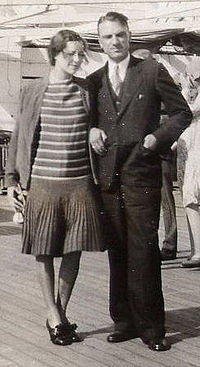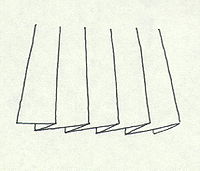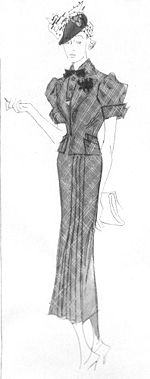
Pleat
Encyclopedia


Textile
A textile or cloth is a flexible woven material consisting of a network of natural or artificial fibres often referred to as thread or yarn. Yarn is produced by spinning raw fibres of wool, flax, cotton, or other material to produce long strands...
back upon itself and securing it in place. It is commonly used in clothing
Clothing
Clothing refers to any covering for the human body that is worn. The wearing of clothing is exclusively a human characteristic and is a feature of nearly all human societies...
and upholstery
Upholstery
Upholstery is the work of providing furniture, especially seats, with padding, springs, webbing, and fabric or leather covers. The word upholstery comes from the Middle English word upholder, which referred to a tradesman who held up his goods. The term is equally applicable to domestic,...
to gather a wide piece of fabric to a narrower circumference.
Pleats are categorized as pressed, that is, ironed
Ironing
Ironing is the use of a heated tool to remove wrinkles from fabric. The heating is commonly done to a temperature of 180-220 °Celsius, depending on the fabric. Ironing works by loosening the bonds between the long-chain polymer molecules in the fibers of the material...
or otherwise heat-set into a sharp crease, or unpressed, falling in soft rounded folds.
Pleats sewn into place are called tucks
Tuck (sewing)
In sewing, a tuck is a fold or pleat in fabric that is sewn in place.Small tucks, especially multiple parallel tucks, may be used to decorate clothing or household linens...
.
Types of pleats
- Accordion pleats are the most basic form of pleat, consisting of a series of permanent folds of equal width in alternating opposite directions. When pressed flat in one direction, accordion pleats become knife pleats. Accordion pleats are rarely used in dressmaking, but are used to make folding fansFan (implement)A hand-held fan is an implement used to induce an airflow for the purpose of cooling or refreshing oneself. Any broad, flat surface waved back-and-forth will create a small airflow and therefore can be considered a rudimentary fan...
.
- Box pleats are knife pleats back-to-back, and have a tendency to spring out from the waistline. They have the same 3:1 ratio as knife pleats, and may also be stacked to form stacked box pleats. These stacked box pleats create more fullness and have a 5:1 ratio. They also create a bulkier seam. Inverted box pleats have the "box" on the inside rather than the outside.
- Cartridge pleats are used to gather a large amount of fabric into a small waistband or armscye without adding bulk to the seam. This type of pleating also allows the fabric of the skirt or sleeve to spring out from the seam. During the 15th and 16th centuries, this form of pleating was popular in the garments of men and women. Fabric is evenly gathered using two or more lengths of basting stitches, and the top of each pleat is whipstitched onto the waistband or armscye. Cartridge pleating was resurrected in the 1840s1840s in fashion1840s fashion in European and European-influenced clothing is characterized by a narrow, natural shoulder line following the exaggerated puffed sleeves of the later 1820s and 1830s...
to attach the increasingly full bell-shaped skirts to the fashionable narrow waist.
- Fluted pleats or flutings are very small, rounded or pressed pleats used as trimmingsTrim (sewing)Trim or trimming in clothing and home decorating is applied ornament, such as gimp, passementerie, ribbon, ruffles, or, as a verb, to apply such ornament....
. The name comes from their resemblance to a pan flutePan fluteThe pan flute or pan pipe is an ancient musical instrument based on the principle of the closed tube, consisting usually of five or more pipes of gradually increasing length...
.
- Fortuny pleats are crisp pleats set in silk fabrics by designer Mariano FortunyMariano Fortuny (designer)Mariano Fortuny y Madrazo, , son of the painter Mariano Fortuny y Marsal, was a Spanish fashion designer who opened his couture house in 1906 and continued until 1946.- Life :...
in the early 20th century, using a secret pleat-setting process which is still not understood.
- Honeycomb pleats are narrow, rolled pleats used as a foundation for smockingSmockingSmocking is an embroidery technique used to gather fabric so that it can stretch. Before elastic, smocking was commonly used in cuffs, bodices, and necklines in garments where buttons were undesirable. Smocking developed in England and has been practised since the Middle Ages and is unusual among...
.
- Knife pleats are used for basic gatheringGather (sewing)Gathering is a sewing technique for shortening the length of a strip of fabric so that the longer piece can be attached to a shorter piece. It is commonly used in clothing to manage fullness, as when a full sleeve is attached to the armscye or cuff of a shirt, or when a skirt is attached to a...
purposes, and form a smooth line rather than springing away from the seam they have been gathered to. The pleats have a 3:1 ratio–three inches of fabric will create one inch of finished pleat. Knife pleats can be recognized by the way that they overlap in the seam.
- Organ pleats are parallel rows of softly rounded pleats resembling the pipes of a pipe organPipe organThe pipe organ is a musical instrument that produces sound by driving pressurized air through pipes selected via a keyboard. Because each organ pipe produces a single pitch, the pipes are provided in sets called ranks, each of which has a common timbre and volume throughout the keyboard compass...
. Carl Köhler suggests that these are made by inserting one or more gores into a panel of fabric.
- Plissé pleats are narrow pleats set by gathering fabric with stitches, wetting the fabric, and "setting" the pleats by allowing the wet fabric to dry under weight or tension. LinenLinenLinen is a textile made from the fibers of the flax plant, Linum usitatissimum. Linen is labor-intensive to manufacture, but when it is made into garments, it is valued for its exceptional coolness and freshness in hot weather....
chemises or smocksChemiseThe term chemise or shift can refer to the classic smock, or else can refer to certain modern types of women's undergarments and dresses...
pleated with this technique have been found in the 10th century VikingVikingThe term Viking is customarily used to refer to the Norse explorers, warriors, merchants, and pirates who raided, traded, explored and settled in wide areas of Europe, Asia and the North Atlantic islands from the late 8th to the mid-11th century.These Norsemen used their famed longships to...
graves in BirkaBirkaDuring the Viking Age, Birka , on the island of Björkö in Sweden, was an important trading center which handled goods from Scandinavia as well as Central and Eastern Europe and the Orient. Björkö is located in Lake Mälaren, 30 kilometers west of contemporary Stockholm, in the municipality of Ekerö...
.
- Rolled pleats create tubular pleats which run the length of the fabric from top to bottom. A piece of the fabric to be pleated is pinched and then rolled until it is flat against the rest of the fabric, forming a tube. A variation on the rolled pleat is the stacked pleat, which is rolled similarly and requires at least five inches of fabric per finished pleat. Both types of pleating create a bulky seam.
- Watteau pleats are one or two box pleats found at the back neckline of 18th century gowns and some late 19th century1890s in fashionFashion in the 1890s in European and European-influenced countries is characterized by long elegant lines, tall collars, and the rise of sportswear.-Women's fashions:...
tea gownTea gownA tea gown or tea-gown is a woman's at-home dress for informal entertaining of the late 19th to mid-20th centuries characterized by unstructured lines and light fabrics. Early tea gowns were a European development influenced by Asian clothing, part of the japonism of Aesthetic dress...
s in imitation of these. The term is not contemporary, but is used by costume historians in reference to these styles as portrayed in the paintings of Antoine WatteauAntoine WatteauJean-Antoine Watteau was a French painter whose brief career spurred the revival of interest in colour and movement...
.
Modern usage

Shirts, blouses, jackets
ShirtsDress shirt
A shirt, or dress shirt in American English, is a garment with a collar, a full-length opening at the front from the collar to the hem, and sleeves with cuffs. Shirts are predominantly used by men, since women usually wear blouses...
and blouse
Blouse
A blouse is a loose-fitting upper garment that was formerly worn by workmen, peasants, artists, women and children. It is typically gathered at the waist so that it hangs loosely over the wearer's body. Today, the word most commonly refers to a woman's shirt but can also refer to a man's shirt if...
s typically have pleats on the back to provide freedom of movement and on the arm where the sleeve tapers to meet the cuff. The standard men's shirt has a box pleat in the center of the back just below the shoulder or alternately one simple pleat on each side of the back.
Jacket
Jacket
A jacket is a hip- or waist-length garment for the upper body. A jacket typically has sleeves, and fastens in the front. A jacket is generally lighter, tighter-fitting, and less insulating than a coat, which is outerwear...
s designed for active outdoor wear frequently have pleats (usually inverted box pleats) to allow for freedom of movement. Norfolk jacket
Norfolk jacket
A Norfolk jacket is a loose, belted, single-breasted jacket with box pleats on the back and front, with a belt or half-belt. The style was long popular for boys' jackets and suits, and is still used in some uniforms. It was originally designed as a shooting coat that did not bind when the elbow...
s have double-ended inverted box pleats at the chest and back.
Skirts and kilts
Skirts, dresses and kiltKilt
The kilt is a knee-length garment with pleats at the rear, originating in the traditional dress of men and boys in the Scottish Highlands of the 16th century. Since the 19th century it has become associated with the wider culture of Scotland in general, or with Celtic heritage even more broadly...
s can include pleats of various sorts to add fullness from the waist or hips, or at the hem, to allow freedom of movement or achieve design effects.
- One or more kick pleats may be set near the hem of a straight skirt to allow the wearer to walk comfortably while preserving the narrow style line.
- Modern kilts may be made with either box pleats or knife pleats, and can be pleated to the stripe or pleated to the sett (see main article Kilts: Pleating and stitching).
Trousers
Pleats just below the waistband on the front of the garment are typical of many styles of formal and casual trousersTrousers
Trousers are an item of clothing worn on the lower part of the body from the waist to the ankles, covering both legs separately...
including suit
Suit (clothing)
In clothing, a suit is a set of garments made from the same cloth, consisting of at least a jacket and trousers. Lounge suits are the most common style of Western suit, originating in the United Kingdom as country wear...
trousers and khakis. There may be one, two, three, or no pleats, which may face either direction. When the pleats open towards the pockets they are called reverse pleats (typical of khakis and corduroy trousers) and when they open toward the zipper, they are known as forward pleats.
Utilitarian or very casual styles such as jeans
Jeans
Jeans are trousers made from denim. Some of the earliest American blue jeans were made by Jacob Davis, Calvin Rogers, and Levi Strauss in 1873. Starting in the 1950s, jeans, originally designed for cowboys, became popular among teenagers. Historic brands include Levi's, Lee, and Wrangler...
and cargo pants
Cargo pants
Cargo pants are loosely-cut pants designed for tough, outdoor activities distinguished by multiple cargo pockets.A cargo pocket is a form patch pocket with accordion folds for increased capacity closed with a flap secured by snap, button, or Velcro common on battledress and hunting clothing.Cargo...
are flat-front (without pleats at the waistband) but may have bellows pockets.
Pockets
A bellows pocket is patch pocketPocket
A pocket is a bag- or envelope-like receptacle either fastened to or inserted in an article of clothing to hold small items. Pockets may also be attached to luggage, backpacks, and similar items...
with an inset box pleat to allow the pocket to expand when filled. Bellows pockets are typical of cargo pants, safari jacket
Safari jacket
A safari jacket or bush jacket is a garment originally designed for the purpose of going on safari in the African bush.Popularized by turn-of-the-20th-century Anglo-African adventurers, safari-style jackets were engineered for comfort and function....
s, and other utilitarian garments.
Gallery
- Painting of accordion pleated folding fan, Japan, 19th century
- Afternoon costume with box pleated skirt and unpressed box pleated bodice panel, France, 1886
- Fortuny pleated tea gownTea gownA tea gown or tea-gown is a woman's at-home dress for informal entertaining of the late 19th to mid-20th centuries characterized by unstructured lines and light fabrics. Early tea gowns were a European development influenced by Asian clothing, part of the japonism of Aesthetic dress...
, 1917 - Golfing jackets with inverted box pleats in the back for movement, 1920s
- Knife-pleated kilt with pleats sewn down to the hip line, 2005
- Organ pleated gown, Florentine, 1470
- Tea gowns with Watteau-pleated backs, Russia, 1899

